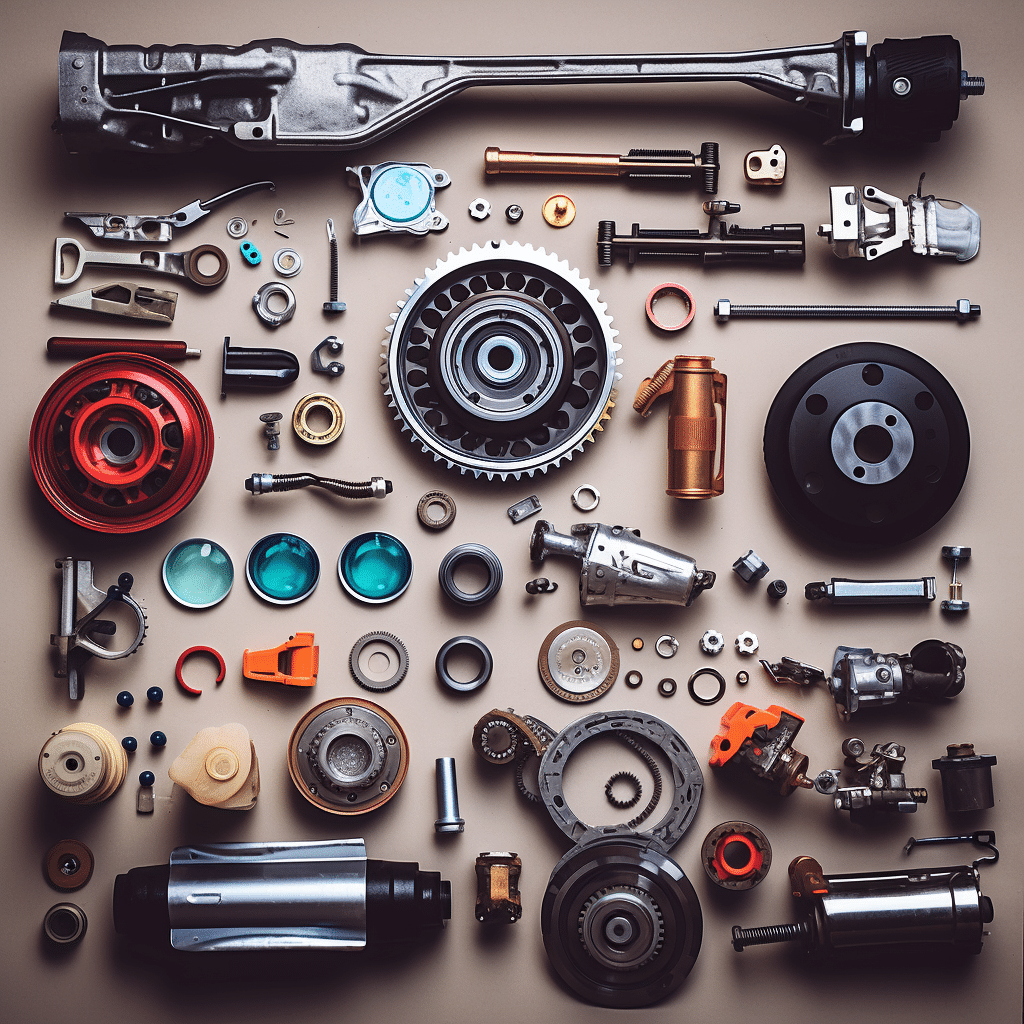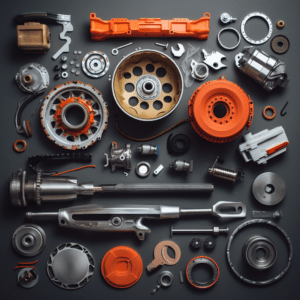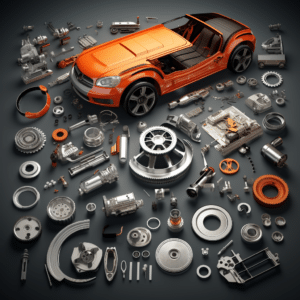
Maximizing Savings: Understanding Interchangeable Car Parts
Interchangeability of car parts is a big deal in vehicle repair and maintenance. It saves time, money and effort – being able to replace worn or damaged parts with compatible ones. Understand which parts are interchangeable among different car models and brands.
For example, spark plugs, air filters, and gas caps usually fit in most vehicles. But, some parts like engine blocks or transmission systems may only fit within the same model or year. So, be sure to check the manufacturer’s specifications and get professional advice to make sure you get the right fit.
Also, some interchangeable need modifications for proper functionality. Usually, this happens with headlights, taillights, or mirrors as designs and technologies keep changing. So, while it can be convenient to switch out parts, customizing might be necessary.
Pro Tip: When buying replacements, always go to a reliable dealer or authorized supplier who can guarantee parts compatibility based on product knowledge. High-quality components from trusted sources give more reliability and less compatibility problems in the future.
In conclusion, understanding interchangeability of car parts helps mechanics and DIYers alike in vehicle repair and maintenance. With constant changes in auto parts, it’s important to stay informed and rely on experts for advice. Knowing interchangeability potential is key to better rides ahead!
What are interchangeable car parts?

To better understand what interchangeable car parts are and how they can be beneficial, delve into the sub-sections explaining these parts. Gain insights into the concept and significance of interchangeable car parts, and discover the advantages they offer in terms of convenience and cost-effectiveness.
Explanation of interchangeable car parts
Interchangeable car parts are made to fit into multiple vehicles of the same make and model. They are built with precision and accuracy, allowing them to be swapped in without any modifications. This saves time and money for mechanics and owners alike.
What’s more, these parts are often compatible across different generations. For instance, you may find one type of engine that fits several years’ worth of vehicles. This means older models can benefit from newer and more efficient engines.
Eli Whitney revolutionized production processes with his idea of interchangeability in the early 19th century. He first used it in musket manufacturing. Later, it was adopted by the automotive industry, making repairs and replacements more affordable and accessible for vehicle owners around the world.
Benefits of interchangeable car parts
To maximize the advantages of interchangeable car parts, delve into the benefits they bring. Enjoy cost savings, increased availability, and flexibility in repairs and modifications. These sub-sections will provide you with a clear understanding of why opting for interchangeable car parts is the solution you need.
Cost savings
Interchangeable car parts = money-saving heaven! With parts that can be conveniently swapped between cars, no more expensive branded components needed. Plus, the easy interchangeability helps cut maintenance costs. Mechanics can replace faulty parts quickly, leading to reduced labor fees and faster repair times. Lastly, drivers get to pick from various suppliers and choose the best deal for their budget. By opting for interchangeable parts, car owners can get the most bang for their buck without compromising on reliability or safety.
Increased availability
Increased availability of interchangeable car parts offers many advantages. These consist of competitive pricing, innovation, and quality improvement. Plus, easy customization and upgrades.
Vehicle owners can easily switch between different brands or models without worrying about compatibility. Offering them flexibility in picking the best for their needs and preferences.
Prolonging the lifespan of vehicles by replacing faulty components instead of discarding whole vehicles. Thus, reducing waste generation.
Henry Ford brought in standardized components for his Model T cars. Enhancing efficiency in production and making repairs simpler for consumers.
Overall, the availability of interchangeable car parts boosts convenience, affordability, customization, and sustainability in the automotive industry. An ongoing process of growth and development.
Flexibility in repairs and modifications
Interchangeable car parts offer several advantages for car owners. Swapping out parts simplifies repairs, permits customization, and can lead to cost-savings.
Plus, these benefits extend beyond repairs and modifications. Interchangeable parts make it easier to source replacements from a variety of brands. Also, they promote sustainability by reducing the need for new parts.
Furthermore, the standardized designs of modern vehicles make it easier to find compatible interchangeable parts.
An example of this is Mark’s story. He was driving on a deserted road when his car suddenly stopped. Fortunately, he was able to quickly replace the faulty part with one from a neighboring vehicle. Thus, demonstrating the convenience and flexibility of interchangeable parts.
In summary, these components revolutionize the way we approach vehicle maintenance. They bring practicality, cost-effectiveness, and convenience to car owners and mechanics alike.
How to identify interchangeable car parts
To identify interchangeable car parts, efficiently research vehicle models and years. Access car part catalogs or databases and seek advice from automotive experts or forums. These sub-sections offer solutions for determining which car parts can be interchanged, saving you time and money on repairs or upgrades.
Researching vehicle models and years
Gather accurate info on vehicle models and years. Research thoroughly to stay up-to-date on versions and variations. Create a table to compare and identify interchangeable parts. An example:
Vehicle Model – 2010-2015 Honda Civic, 2012-2018 Toyota Corolla, 2005-2010 Ford Mustang.
Check for compatibility between models and production years. Plus watch out for any variations in each model’s production cycle. Investing time in research and visual aids can save effort and prevent costly mistakes. Don’t let uncertainty hold you back—take action now!
Consulting car part catalogs or databases
Consulting car part catalogs or databases is key for finding interchangeable car parts. They offer precise details about compatibility and measurements, model years, vehicle makes, and more. Plus, you get reviews, ratings, and pricing info!
Benefits:
- Accuracy: Get the right replacement component.
- Extensive Info: Comprehensive search.
- Multiple Options: Choose from different manufacturers.
- Time Efficiency: Swiftly locate the required part.
Don’t forget to consult car part catalogs or databases for your car repairs. Enjoy accuracy, info, options, and time efficiency when searching for the perfect match. Happy hunting!
Seeking advice from automotive experts or forums
Don’t miss out! Tap into the collective wisdom of automotive enthusiasts by seeking advice from automotive experts or exploring forums. You’ll be able to access accurate and reliable information, discover hidden alternatives, benefit from expertise, gain insights from real experiences, and save time and money. Plus, you’ll enjoy the sense of community that these platforms offer.
If you want to make the most of this resource, be active in online discussions, ask specific questions about your car model or part requirements, and express gratitude for any assistance received. This encourages an ongoing exchange of knowledge within the community.
So don’t hesitate—embrace the fear of missing out on critical information that could help improve your car’s performance. Join automotive expert or forum communities today for the edge you need to make informed decisions about interchangeable car parts.
Precautions when using interchangeable car parts
To ensure a smooth and safe experience when using interchangeable car parts, take the necessary precautions. Ensure compatibility and fitment, considering both safety and performance implications. Additionally, opt for professional installation and thorough inspection to guarantee a seamless integration of the interchangeable components.
Ensuring compatibility and fitment
Investigate the exact car model and year! Check the part number to make sure it’s the same as the old one. Measure the part accurately to ensure a good fit. Confirm compatibility with other components in your car.
Remember these tips:
- Know the specs of the new part – slight changes can affect performance.
- Ask a mechanic or pro for advice on compatibility.
AAA states that about two-thirds of vehicle breakdowns are due to faulty parts and fluids.
Considering safety and performance implications
Interchangeable car parts have potential consequences for safety and performance. Weighing these factors is key for a secure ride. Let’s look at how these parts affect safety and performance.
Aspect: Brakes
Safety Implications: Compatible brake pads reduce malfunctioning during critical moments.
Performance Implications: Quality brakes improve efficiency and responsiveness.
Aspect: Suspension System
Safety Implications: Poorly-matched parts can cause handling issues & accidents.
Performance Implications: Optimal components lead to better control, comfort & cornering.
Aspect: Engine Components
Safety Implications: Incompatible parts can cause reduced power, emissions & engine failure.
Performance Implications: High-quality components bring optimal power, fuel & longevity.
Stick to manufacturer guidelines. Aftermarket or cheaper parts may be tempting, but OEM specs are essential for safety and performance.
The auto industry has evolved with interchangeability in mind. Standardized sizes & specifications have improved safety & performance. Without this, the automotive landscape would be more dangerous.
For safer and better performance, research and consult professionals. This will ensure compatibility and avoid potential problems.
Professional installation and inspection
- Always get a pro mechanic to fit the parts.
- Check the parts for damage or defects before fitting.
- Make sure all connections and clasps are tight.
- Get a technician to inspect the car after installation.
- Schedule regular maintenance inspections.
- Also, tell the mechanic the car’s make, model and year.
- Don’t take short-cuts! Safety first – let the experts make sure you’re safe on the road.
Popular interchangeable car parts
To better understand the popular interchangeable car parts, let’s dive into examples of commonly interchangeable car parts and discover the benefits and considerations for each example. This will give you insights into the practicality and advantages of swapping out specific car parts to address your needs or enhance your vehicle’s performance.
Examples of commonly interchangeable car parts
Interchangeable car parts are a blessing for car owners and mechanics. They enable easy repairs, cost-effective maintenance, plus efficient customization. Here’s a few of the common interchangeable parts:
Engine Components:
- Spark Plugs
- Fuel Injectors
- Air Filters
Transmission Parts:
- Clutch Kits
- Drive Belts
- Shifters
Suspension Elements:
- Control Arms
- Struts
- Sway Bars
Braking System Parts:
- Brake Pads
- Rotors
- Calipers
Electrical Components:
- Alternators
- Batteries
- Ignition Coils
Exterior Accessories:
- Mirrors
- Headlights
- Grilles
Interior Parts:
- Seats Covers
- Dashboards
- Carpets
These are only some of the many interchangeable car parts. They all have distinct purposes, but are compatible with different car models. This adds convenience and accessibility. Knowing these components helps car owners make informed decisions when it comes to repairs or upgrades.
Unlock the advantages of interchangeable car parts! Save time, money and effort. Both experienced mechanics and DIYers can benefit from these parts. Harness their versatility and unleash your creative side today!
Benefits and considerations for each example

Interchangeable car parts offer many perks! Cost savings, convenience, and flexibility for repairs and maintenance. Weigh these factors when considering whether to use them!
Other points to consider:
- Compatibility with your vehicle.
- Quality of aftermarket parts.
- Warranty coverage.
Certain car makers may have restrictions that limit the use of interchangeable parts. Research and check for compatibility before making changes.
When deciding on interchangeable car parts, analyze all the pros and cons. Cost savings, convenience and flexibility – plus compatibility and quality issues. Do your research so you can make the best decision for you.
Don’t miss out on the advantages of interchangeable car parts. Money saved, convenience, and easy repairs. Explore compatible options for your vehicle and get these benefits today.
Conclusion
Interchangeable car parts? Let’s take a peek! Engines, transmissions, suspensions, brakes – lots of parts can be transferred between vehicles with similar specs. With interchangeability comes convenience, plus more choices for buying replacement parts. But wait, there’s more! Even parts that look the same may have variations in the manufacturing process. Do your research, talk to experts, and read your vehicle’s manual before making any swaps. Seeking help from pros with car part knowledge is a great idea – they can point you in the right direction and offer valuable advice tailored to your car!
Frequently Asked Questions
FAQs about Interchangeable Car Parts:
1. What are interchangeable car parts?
Interchangeable car parts are components that are designed to be used in different vehicles of the same make, model, or sometimes even across different brands. These parts have similar specifications, dimensions, and functionality, allowing them to be used interchangeably.
2. Which car parts are commonly interchangeable?
Some commonly interchangeable car parts include air filters, oil filters, brake pads, spark plugs, headlights, tail lights, and mirrors. However, the interchangeability of parts varies depending on the manufacturer and model of the vehicle.
3. How can I determine if a car part is interchangeable?
To determine if a car part is interchangeable, you can refer to the vehicle’s service manual or consult with a reputable mechanic. You can also search for compatible parts using online databases or contact the manufacturer or authorized dealers for guidance.
4. Are all interchangeable parts brand-specific?
No, not all interchangeable parts are brand-specific. While some parts may be designed specifically for certain brands or models, there are also generic parts available that fit multiple makes and models. It’s important to research and ensure compatibility before purchasing interchangeable parts.
5. Are aftermarket car parts interchangeable?
Yes, aftermarket car parts can be interchangeable with original equipment manufacturer (OEM) parts or even with other aftermarket parts. However, it is crucial to choose reputable aftermarket brands that rigorously test their products for compatibility and quality.
6. Can I replace an interchangeable part myself?
Replacing interchangeable car parts can be relatively simple if you have basic automotive knowledge and the right tools. However, some parts may require professional installation to ensure proper fitment and performance. If you’re unsure, it’s always best to consult with a certified mechanic.
